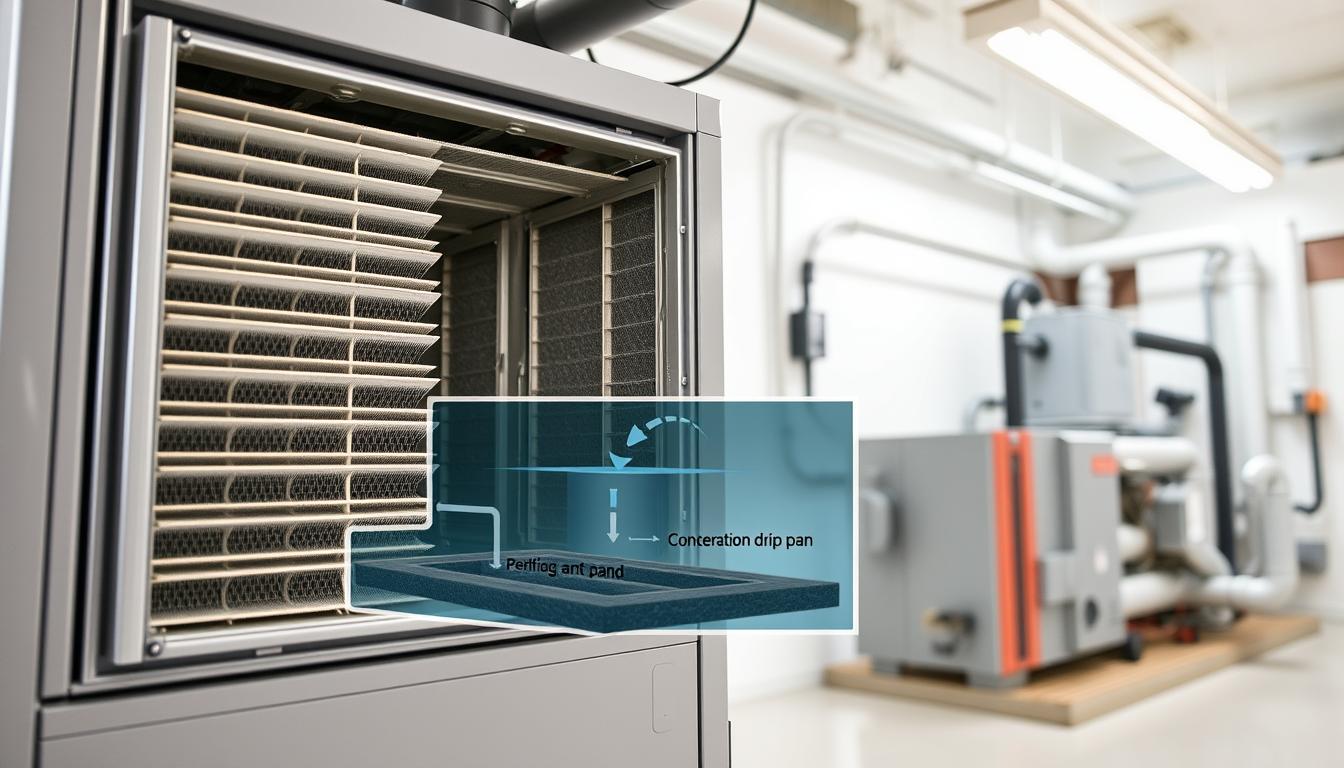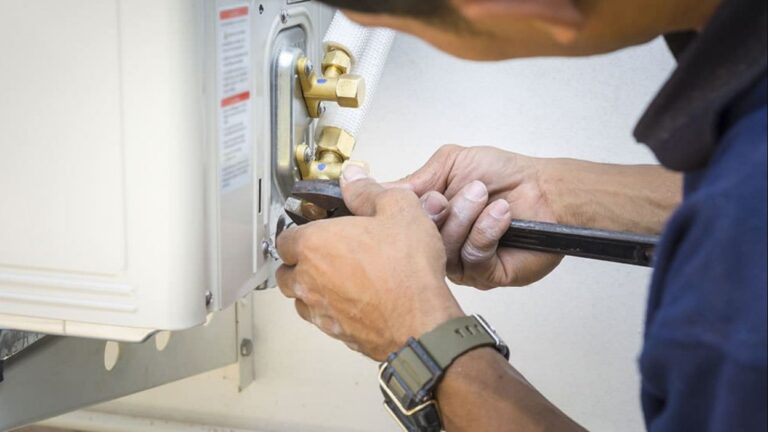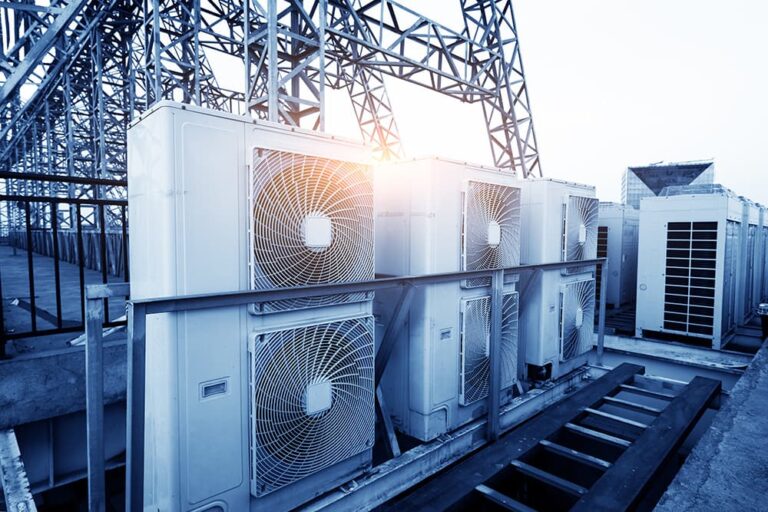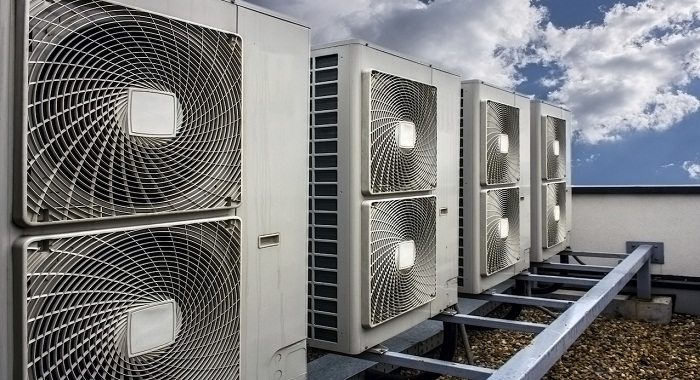How to Prevent Mold in Your HVAC System
Mold growth in heating, ventilation, and air conditioning systems is a common issue that can significantly impact indoor air quality and your family’s health. According to the U.S. EPA, routine inspections of your HVAC systems are crucial, not just for mold, but for moisture as well.
Mold spores are always present in the air and become visible when they land on a damp surface and begin to grow. By controlling moisture in your system and maintaining optimal humidity levels in your home, you can protect your living space and HVAC system from mold. For more detailed information on preventing mold, you can visit this resource.
Key Takeaways
- Regular maintenance is essential to prevent mold growth in your HVAC system.
- Controlling moisture and humidity levels is crucial for mold prevention.
- High-efficiency air filters can capture airborne particles, including mold spores.
- UV germicidal lights can help sterilize the air and kill mold spores.
- Optimal indoor humidity levels should be between 30% and 60%.
Understanding Mold Growth in HVAC Systems
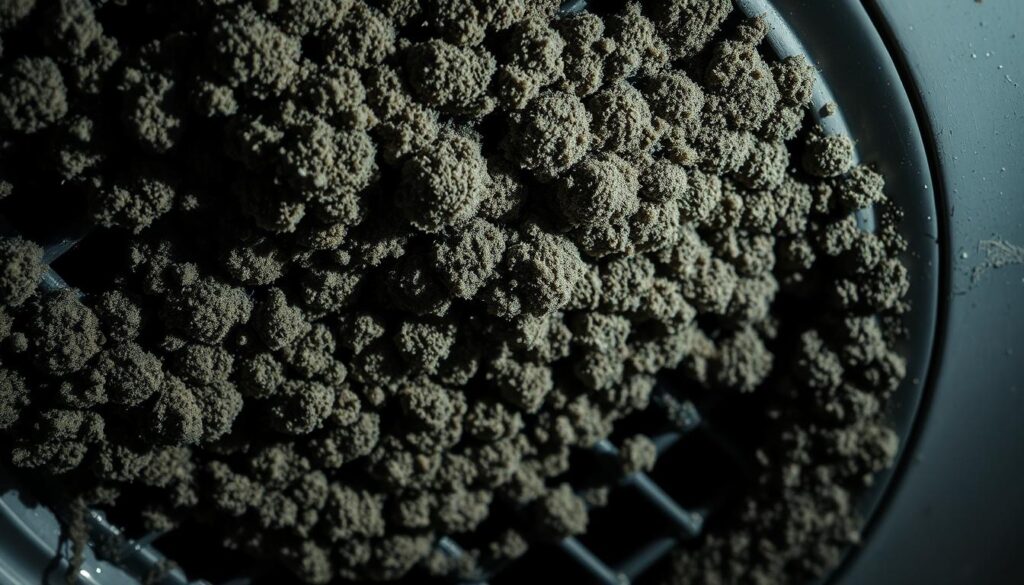
Understanding how mold grows in HVAC systems is crucial for maintaining a healthy indoor environment. Mold growth is a significant concern because it can lead to various health issues and damage to the HVAC system itself.
Why Mold Develops in HVAC Units
Mold needs three essential elements to grow: warmth, moisture, and food. HVAC systems inadvertently create these conditions. The evaporator coil in the air conditioning system cools the air and extracts moisture, creating condensation. If this condensation is not properly drained, it provides the moisture that mold needs to thrive. Moreover, dust and debris accumulated in the system serve as a food source for mold.
As mold spores are constantly present in indoor air, when they land on damp surfaces within the HVAC system, they can quickly establish colonies. The combination of moisture from condensation, warmth from the system’s operation, and organic matter creates an ideal environment for mold growth.
The Perfect Conditions for Mold Growth
The perfect conditions for mold growth are often met within HVAC systems. Humidity levels above 60% significantly increase the risk of mold development, making humidity control a crucial factor in prevention. Poorly maintained systems with clogged filters, dirty coils, or blocked condensate lines create environments where mold can flourish undisturbed.
| Condition | Description | Impact on Mold Growth |
|---|---|---|
| Moisture | Condensation from evaporator coils | Provides necessary moisture for mold |
| Warmth | System operation and indoor temperatures | Creates a conducive environment for mold |
| Food Source | Dust and debris in the system | Serves as nutrients for mold growth |
As noted by experts, “Removing any one of these elements can prevent mold growth.” Understanding these factors is essential for implementing effective prevention strategies that target the root causes of mold development.
Health Risks of Mold in Your HVAC System
Mold growth in HVAC systems poses significant health risks to occupants. Mold spores released into the air can cause a variety of health issues, ranging from mild allergic reactions to severe respiratory problems.
Common Health Symptoms from HVAC Mold Exposure
Exposure to mold in HVAC systems can lead to several health symptoms. Common reactions include coughing, wheezing, nasal congestion, throat irritation, and eye irritation. These symptoms are often mistaken for seasonal allergies or common colds, making it crucial to identify the root cause.
Health impacts can be more severe for individuals with pre-existing conditions. For instance, mold exposure can trigger asthma attacks and exacerbate breathing difficulties.
| Symptoms | Description |
|---|---|
| Coughing and Wheezing | Respiratory reactions to mold exposure |
| Nasal Congestion | Nasal irritation due to mold spores |
| Eye and Throat Irritation | Allergic reactions manifesting in irritation |
Who Is Most Vulnerable to Mold-Related Health Issues
Certain groups are more susceptible to the health risks associated with mold exposure. These include children, elderly individuals, pregnant women, and those with compromised immune systems. For these groups, mold exposure can lead to more serious health complications.
Understanding the health risks associated with mold in HVAC systems is crucial for maintaining a healthy indoor environment. By recognizing the symptoms and identifying vulnerable individuals, homeowners can take proactive steps to prevent mold growth and ensure good indoor air quality.
Identifying Signs of Mold in Your HVAC System
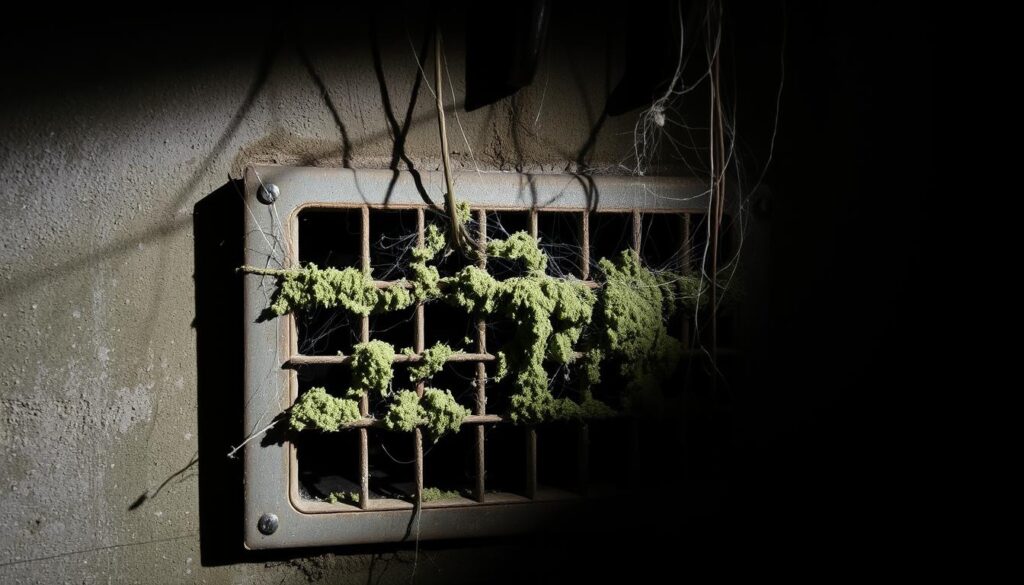
To keep your home’s air clean and healthy, it’s essential to recognize the signs of mold in your HVAC system. Mold growth can lead to poor air quality, affecting your family’s health and comfort. Regular checks can help you identify potential issues before they become major problems.
Visual Indicators of Mold Presence
Visible mold growth on vents, registers, or around the air handler unit is a clear sign of mold presence. Look for black, green, or brown spots or patches, which can indicate mold growth. Inspecting these areas regularly can help you catch mold issues early.
Odor and Air Quality Changes
A persistent musty or earthy odor, especially when your HVAC system is running, is often the first indicator of mold presence. Additionally, if you notice increased allergy symptoms or unexplained respiratory issues when the system is operating, it may be a sign that mold spores are being distributed through your home’s air.
Inspecting Key Components for Mold Growth
To identify mold, focus on areas prone to moisture: the evaporator coil, condensate drain pan, air filters, and ductwork. Use a flashlight to examine these components for any signs of discoloration, water damage, or actual mold growth. Regular inspection of these key areas can help you catch mold problems early.
By being aware of these signs and regularly inspecting your HVAC system, you can maintain good air quality and prevent mold-related health issues.
Effective HVAC Mold Prevention Strategies
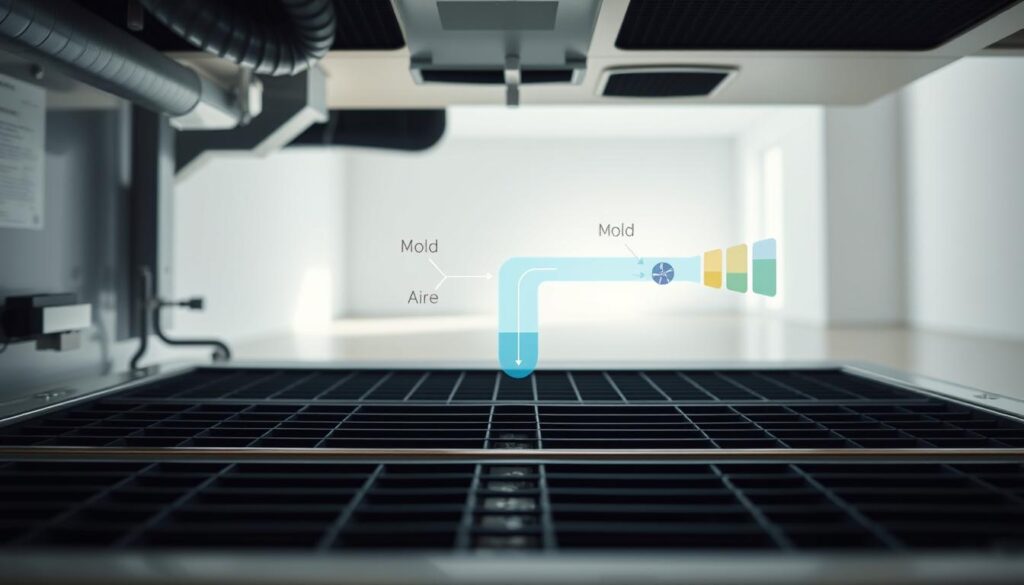
Effective mold prevention strategies for your HVAC system can significantly improve the air you breathe at home. By implementing a few simple measures, you can prevent mold growth and maintain a healthy indoor environment. This involves controlling humidity levels, regular maintenance, ensuring proper ventilation, and leveraging advanced technologies like UV light.
Controlling Indoor Humidity Levels
Maintaining indoor humidity levels between 30-50% is crucial for preventing mold growth in your HVAC system and throughout your home. According to the Environmental Protection Agency (EPA), this range is ideal for comfort and mold prevention. Consider installing a whole-house dehumidifier, especially if you live in a humid climate like Miami or Houston. This can help keep your home’s humidity in check, reducing the risk of mold and other moisture-related issues.
Regular Filter Maintenance and Replacement
Regularly replacing air filters is a simple yet effective way to prevent mold growth. Dust accumulation on filters can become a food source for mold, so changing them every 30-90 days is recommended, depending on the filter type and household conditions. For more information on maintaining your HVAC system, you can visit AireServ’s blog on mold prevention.
Proper Ventilation Techniques
Ensuring proper airflow throughout your home is vital for preventing mold. Keep vents unblocked and regularly clean return air registers to maintain balanced air pressure. Proper ventilation in high-moisture areas like bathrooms and kitchens also helps reduce overall humidity levels. By doing so, you create an environment less conducive to mold growth.
UV Light Technology for Mold Prevention
UV light technology is an effective add-on feature for improving indoor air quality and preventing mold growth. HVAC UV lights use UVC ultraviolet light to kill microorganisms by penetrating their cellular walls and destroying their DNA. This technology can be particularly effective when installed in your air handler, helping to keep coils and other internal components mold-free.
By combining these strategies—controlling humidity, maintaining filters, ensuring proper ventilation, and using UV light technology—you can significantly reduce the risk of mold growth in your HVAC system. This not only improves indoor air quality but also contributes to a healthier living environment for you and your family.
DIY Mold Cleaning and Removal Methods
To prevent the spread of mold and maintain good air quality, understanding DIY mold cleaning methods for your HVAC system is vital. Mold growth in HVAC systems can lead to serious health issues and compromise the system’s efficiency.
Safety Precautions Before Cleaning
Before starting any DIY mold cleaning, ensure your safety by turning off the power to the HVAC system. Wear protective gear including an N-95 respirator mask, gloves, and eye protection to avoid exposure to mold spores. This is crucial for preventing health issues related to mold exposure.
Step-by-Step Cleaning Process for Accessible Components
For accessible components like vents, registers, and the exterior of your air handler, use a solution of equal parts white vinegar and water to effectively kill mold and prevent regrowth. Avoid dry-brushing or disturbing the mold to prevent releasing spores into the indoor air. Instead, use damp cleaning methods. For the condensate drain pan and line, flush with a mixture of one part bleach to 16 parts water.
Effective Cleaning Solutions and Products
For more extensive cleaning, consider using EPA-registered HVAC disinfectants specifically formulated for mold removal in air conditioning systems. Replace any porous materials that show signs of mold contamination, as they cannot be thoroughly cleaned. Regularly cleaning or replacing air filters is also essential for maintaining good air quality.
| Cleaning Task | Recommended Solution |
|---|---|
| Accessible Components | Equal parts water and vinegar |
| Condensate Drain Pan and Line | 1 part bleach to 16 parts water |
| Non-porous Surfaces | EPA-registered HVAC disinfectants |
As emphasized by experts, “Proper maintenance and regular cleaning of your HVAC system are key to preventing mold growth and ensuring a healthy indoor environment.” Regular DIY mold cleaning and removal can significantly improve the air quality and overall efficiency of your HVAC system.
When to Call Professional HVAC Mold Remediation
DIY cleaning can address minor mold issues, but extensive mold growth or uncertainty about how to safely clean your air conditioner necessitates professional help. Professionals have the expertise and proper equipment to remove mold effectively, ensuring your HVAC system operates efficiently and safely.
Signs of Severe Mold Infestation
Certain signs indicate the need for professional mold remediation services. These include extensive visible mold growth, mold that returns quickly after cleaning, mold inside ductwork, or persistent musty odors despite cleaning efforts. If family members experience ongoing health issues related to mold exposure, or if mold has spread to inaccessible areas of your HVAC system, professional remediation becomes necessary.
| Signs of Severe Mold Infestation | Description |
|---|---|
| Extensive Visible Mold Growth | Mold covering large areas or multiple components of the HVAC system. |
| Mold Inside Ductwork | Mold growth within the ductwork, which can spread mold spores throughout the system. |
| Recurring Mold Issues | Mold that returns quickly after DIY cleaning efforts. |
What to Expect from Professional Mold Remediation
Professional remediation typically involves a comprehensive inspection of your HVAC system to identify all areas of mold growth. Technicians will then implement containment procedures to prevent cross-contamination, followed by specialized cleaning of all system components, including internal parts like evaporator coils and blower assemblies. Antimicrobial treatments may be applied to prevent future mold growth.
Choosing a Qualified HVAC Mold Specialist
When hiring professionals, look for companies with specific certifications in mold remediation and HVAC cleaning, such as membership in the National Air Duct Cleaners Association (NADCA). NADCA members inspect and clean the entire HVAC system, including air ducts, coils, and other components, ensuring a thorough remediation process. They may also apply sanitizers and disinfectants to prevent microbial contamination.
By hiring a qualified professional, you can ensure that your HVAC system is thoroughly cleaned and maintained, preventing future mold growth and ensuring a healthier indoor air quality.
Maintaining a Mold-Free HVAC System Year-Round
tag.
6. Keyword Placement Matrix:
I will develop a keyword placement matrix to ensure that the keyword density is appropriate (up to 2%).
7. Readability and Flesch Score:
I will ensure that the paragraphs are short, and the content adheres to the Flesch Reading Ease and Flesch Kincaid Grade requirements (score between 60-70).
8. Word Count:
The content will be approximately 250 words as specified.
Here’s the analysis and content creation process:
To keep your HVAC system running efficiently and prevent mold growth, a year-round maintenance plan is essential. This involves several key steps that help ensure your system operates effectively while maintaining healthy indoor air quality.
First,schedule professional HVAC maintenanceat least twice a year, ideally before the summer and winter seasons. This ensures your system is clean and functioning optimally. During seasonal transitions, pay special attention tohumidity levelsin your home. Using dehumidifiers during humid months and ensuring proper humidification during dry winter months can significantly reduce the risk of mold growth.
Implementing amonthly filter checking and replacement scheduleis also crucial. More frequent changes may be necessary during high-use periods or if you have pets, allergies, or live in a dusty area. Regularly inspect visible components of your HVAC system, including vents, registers, and the area around your indoor unit, for any signs of moisture or mold development.
Additionally, keeping outdoor condenser units clear of debris and obstructions ensures proper airflow and prevents moisture buildup. Consider installing asmart thermostatto maintain consistent temperature and humidity levels, further preventing mold growth conditions.
To maintain your HVAC system’s integrity during periods of disuse, run your air conditioning system occasionally to prevent stagnant air and moisture accumulation in ducts and components. Also, keep drain lines clear by pouring a cup of vinegar down the condensate drain line every 60-90 days during the cooling season.
By following these steps and maintaining a consistent maintenance schedule, you can ensure your HVAC system remains mold-free and your home’s indoor air quality stays healthy throughout the year.
To keep your HVAC system running efficiently and prevent mold growth, a year-round maintenance plan is essential. This involves several key steps that help ensure your system operates effectively while maintaining healthy indoor air quality.
First, schedule professional HVAC maintenance at least twice a year, ideally before the summer and winter seasons. This ensures your system is clean and functioning optimally. During seasonal transitions, pay special attention to humidity levels in your home. Using dehumidifiers during humid months and ensuring proper humidification during dry winter months can significantly reduce the risk of mold growth.
Implementing a monthly filter checking and replacement schedule is also crucial. More frequent changes may be necessary during high-use periods or if you have pets, allergies, or live in a dusty area. Regularly inspect visible components of your HVAC system, including vents, registers, and the area around your indoor unit, for any signs of moisture or mold development.
Additionally, keeping outdoor condenser units clear of debris and obstructions ensures proper airflow and prevents moisture buildup. Consider installing a smart thermostat to maintain consistent temperature and humidity levels, further preventing mold growth conditions.
To maintain your HVAC system’s integrity during periods of disuse, run your air conditioning system occasionally to prevent stagnant air and moisture accumulation in ducts and components. Also, keep drain lines clear by pouring a cup of vinegar down the condensate drain line every 60-90 days during the cooling season.
By following these steps and maintaining a consistent maintenance schedule, you can ensure your HVAC system remains mold-free and your home’s indoor air quality stays healthy throughout the year.

